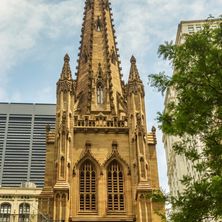

If viewed from Wall Street the façade and spire of this neo-gothic temple are surely an inspiring sight. They look like an ornate rocket, ready to be launched into the stratosphere of global finance. At the time of its construction in 1846, the church, with its 86-meter spire, was the highest building in New York City. Its record was beaten only in 1890 by the New York World Building, which was demolished half a century later.
The first Trinity Church had been erected on the site in 17th century. During the American Revolutionary War, when the British troops occupied New York, all clergy were forced to swear their allegiance to the King. The Great New York City Fire of 1776 burned the church to the ground, taking about another 500 buildings with it.
The second Trinity Church went up at the end of 18th century, just as New York's tenure as America's first capital came to an end. However, the church functioned for only forty years. It was taken down after the severe snowstorms of 1830's damaged its roof and walls.
The third and current church was designed by the English born architect Richard Upjohn during a period known as the Gothic Revival, which aimed at reintroducing medieval elements such rib vaults, flying buttresses, lancet windows, niched statues and pointed arches not only in churches, but also other public buildings such as universities and governmental institutions. Inside it is simple and austere, as austere as a church can be in the heart of the world's most vital financial district. The tower has 23 bells, which during services could be heard even during the worst traffic jams. In fact, in 2006 the local residents complained and the church created a mechanism for isolating the sound.
Next to Trinity Church is a cemetery that contains tombs of several important Americans, among whom are Robert Fulton and Alexander Hamilton. Fulton was an engineer and inventor who in the beginning of the 19th century contributed in the development of the steamboat and also built what became known as the first practical, that is, usable, submarine. Alexander Hamilton was one of the founding fathers of the Unites States. He was an ardent champion of the Constitution and became the country's first Secretary of the Treasury under President George Washington. In 1804, at the height of his career, he was mortally wounded in a duel with Vice President Aaron Burr.